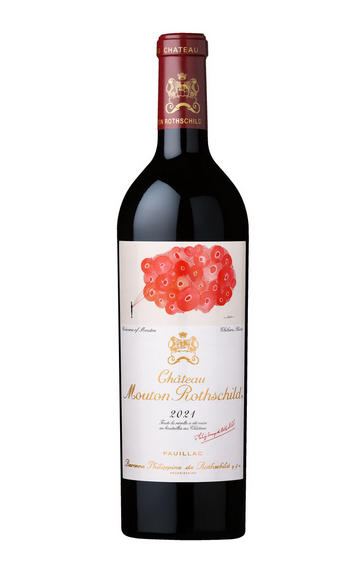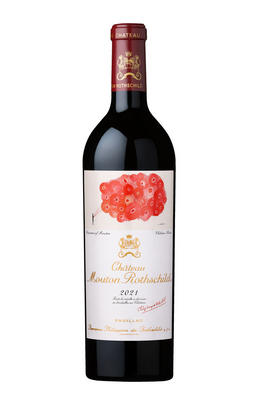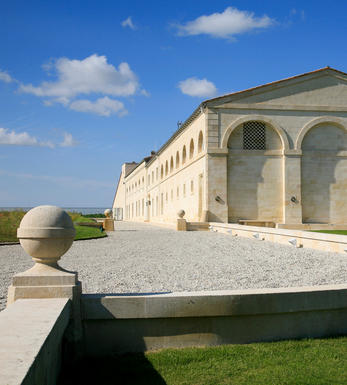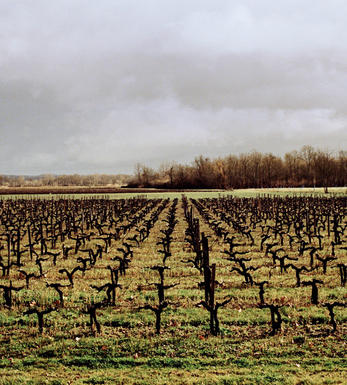
2021 Château Mouton Rothschild, Pauillac, Bordeaux

Critics reviews
The 2021 Mouton Rothschild marks a return to the classic style of this First Growth after three hot vintages. Unsurprisingly, the Cabernet Sauvignon takes control and expresses cigar smoke and graphite aromas. This is very well defined, yet examining the wine over several minutes, I was searching in vain for that "magic touch" exuded in recent vintages. The palate is beautifully-knit, quite edgy on the opening, comparatively slender and markedly sapid. Unapologetically linear on the finish, it is as if the growing season snipped off the frills that defines a great Mouton-Rothschild. This is a very fine First Growth, yet I hope it just gains a bit of weight and, to use a more accurate word, "presence", during the remainder of its barrel maturation. 13.1% alcohol
Drink 2027 - 2050
Neal Martin, vinous.com, (May 2022)
Jewel-ruby in colour, crystalline reflections. This is less exuberant than a usual Mouton, more of a classic Pauillac with intensity and depth through the palate. Plenty of grip and length, with rich layers of raspberry and blackberry fruits and curls of gunsmoke, liqourice and cocoa bean, giving hints of a more generous wine that should be released further over ageing. Focused and supple. 100% new oak. 3.73ph, 59IPT, 41hl/h yield. Harvest September 25 until October 6. The first vintage where it was Jean-Emmauel Danjoy from beginning to end, after Philippe Dhalluin's retiremement. 41% of overall production in Mouton. Strong candidate for an upscore in bottle.
Drink 2028 - 2042
Jane Anson, janeanson.com (May 2022)
Blackcurrant and cranberry notes indicate the dominance of Cabernet in the blend. Meaty but fresh on the palate, the tannins silky and dense. Plenty of substance here, the fruit generous, the tannins firm, providing length on the finish. Rich, within the context of the vintage, but fresh at the same time. Looks to have staying power.
Drink 2030 - 2050
James Lawther, jancisrobinson.com (May 2022)
The 2021 Mouton Rothschild is a terrific wine in the making, unfurling in the glass with aromas of cherries and wild berries mingled with notions of violets, espresso roast, pipe tobacco and mint. Medium to full-bodied, deep and seamless, it's a layered, enveloping wine that's ample and concentrated, with succulent acids, melting tannins and a long, resonant finish. A blend of 89% Cabernet Sauvignon, 10% Merlot and 1% Cabernet Franc that attained 13.1% alcohol, this is a demonstrative, sensual Mouton that's the fruit of extreme selection, and that may well make my score seem conservative with further élevage. Bravo to the talented Jean-Emmanuel Danjoy and his team.
William Kelley, Wine Advocate (Apr 2022)
A firm and compact Mouton with a powerful tannin frame for the vintage, yet it remains fine and precise as it opens to a velvety texture. Black fruit with tar, pencil lead and tobacco. Driven and firm. A little angular and tight at the moment. 89% cabernet sauvignon, 10% merlot and 1% cabernet franc.
James Suckling, jamessuckling.com (May 2022)
About this WINE

Château Mouton Rothschild
Classified as a First Growth, Château Mouton Rothschild has a long and storied history; wine has been made here since Roman times. The property spans 82 hectares of vines in Pauillac, planted with the classic varieties of the region, Cabernet Sauvignon being predominant.
The estate has been in the Baron Philippe de Rothschild family since 1853, but it wasn’t until the arrival of Baron Philippe de Rothschild in 1922 that its fortunes were transformed. Baron Philippe was a dynamic figure who revolutionised the estate and was the first to introduce château-bottling in 1924. He also introduced the concept of commissioning an artist to design each new vintage’s label. Some of the most notable contributors include Salvador Dalí, Henry Moore, Marc Chagall, Francis Bacon, Lucian Freud, Anish Kapoor and Peter Doig.
His daughter Baroness Philippine continued to help raise the estate to new heights with numerous endeavours, including the inauguration of a new vat house in 2013. Today, her three children, Camille and Philippe Sereys de Rothschild and Julien de Beaumarchais de Rothschild, continue the efforts of their predecessors.
Following the retirement in 2020 of Philippe Dhalluin, the winemaking team is now headed up by Jean-Emmanuel Danjoy. With his team, he oversees over 83 hectares of vines, planted with Cabernet Sauvignon (78%), Merlot (18%), Cabernet Franc (3%), and Petit Verdot (1%). The average age of the vines is around 50 years.

Bordeaux
Bordeaux remains the centre of the fine wine world. The maritime climate on the 45th parallel provides for temperate winters and long, warm summers, perfect conditions for growing grapes suited to the production of classically-constructed, long-lasting wines. This vast region of 120,000ha of vineyards (four times the size of Burgundy) is home to 10,000 wine producers and 57 different AOCs. Red now makes up 88 percent of Bordeaux wine, and is usually referred to as Claret. The origin of this name was to differentiate the lighter-coloured wines of the coastal region from the deeper "black" wines from up-country regions.
The Left Bank, comprising the wine regions of the Médoc, Pessac-Léognan and Graves are planted predominantly with Cabernet Sauvignon, which thrives on the gravelly soils left by the ancient course of the river. This is a thick-skinned variety which ripens late, producing powerful, tannic wines capable of long ageing. It is blended with Merlot, Cabernet Franc and sometimes Petit Verdot. The highlights of the Médoc are the four communes of St- Estèphe (blackcurrant concentration); classical, cedarwood and cigar-box Pauillac; richly-fruited St Julien; and elegant, fragrant Margaux.
On the Right Bank, most famously in St-Emilion and Pomerol, it is the fleshy Merlot grape which prevails, sometimes supported by Cabernet Franc. Here the soils are more mixed, with gravel and clay underpinning the rich, fruity wines of Pomerol. Styles vary more in St-Emilion, depending on the predominance of sand in the lower-lying slopes, or limestone on the hillsides and plateau.
By the 18th century, individual properties - known as châteaux, however humble - were becoming known for the quality of their wines and in 1855, those of the Médoc (plus Haut-Brion, a property commended by Samuel Pepys as early as 1663) were classified into five levels of classed growths. Lafite, Latour, Margaux and Haut Brion were cited as First Growths, to whose ranks Mouton Rothschild was elevated by presidential decree in 1973. Beneath the ranks of the classed growths lies a raft of fine châteaux known as Crus Bourgeois, while a host of less well-known "petits châteaux" still makes attractive, enjoyable Claret at affordable prices.
The other jewel in the Bordeaux crown is the district of Sauternes, making some of the most outstanding sweet white wines in the world (from the likes of Châteaux d'Yquem, Rieussec and Climens). The foggy autumn mornings along the banks of the Garonne River near Sauternes and neighbouring Barsac enable the noble rot, botrytis cinerea, to form on the skins of the grapes, which can still ripen in the afternoon sun as late as the end of October or early November. The Sémillon grape is the prime component, but Sauvignon Blanc and a little Muscadelle are also planted to provide insurance if the weather is less favourable to Sémillon, as well as offering a counterpoint in flavour.
There are many inexpensive dry white wines - more Sauvignon than Sémillon - from regions such as Entre-Deux-Mers and Graves, with just a handful of outstanding properties located in Pessac-Léognan. The most famous of the great dry whites hail from Châteaux Haut Brion, Laville Haut Brion and Domaine de Chevalier.
The finer wines of Bordeaux are sold en primeur in the late spring following the harvest, some two years before the wines are ready for physical delivery. The châteaux offer their wines through a system of Bordeaux négociants (brokers) who sell them on to importers round the world. Prices vary enormously from one vintage to another, dependent on perceived quality and world demand, which shows no signs of diminishing, especially for the great years.

Cabernet Sauvignon Blend
Cabernet Sauvignon lends itself particularly well in blends with Merlot. This is actually the archetypal Bordeaux blend, though in different proportions in the sub-regions and sometimes topped up with Cabernet Franc, Malbec, and Petit Verdot.
In the Médoc and Graves the percentage of Cabernet Sauvignon in the blend can range from 95% (Mouton-Rothschild) to as low as 40%. It is particularly suited to the dry, warm, free- draining, gravel-rich soils and is responsible for the redolent cassis characteristics as well as the depth of colour, tannic structure and pronounced acidity of Médoc wines. However 100% Cabernet Sauvignon wines can be slightly hollow-tasting in the middle palate and Merlot with its generous, fleshy fruit flavours acts as a perfect foil by filling in this cavity.
In St-Emilion and Pomerol, the blends are Merlot dominated as Cabernet Sauvignon can struggle to ripen there - when it is included, it adds structure and body to the wine. Sassicaia is the most famous Bordeaux blend in Italy and has spawned many imitations, whereby the blend is now firmly established in the New World and particularly in California and Australia.


Buying options
Add to wishlist
Description
Only a very limited quantity of this wine is available, and sales are handled by our Account Managers. You can find out more about this service here. If you would like to hear about Bordeaux 2021 En Primeur releases, sign up here. You can browse our range of new releases here.
Cabernet Sauvignon 89%, Merlot 10%, Cabernet Franc 1%
At this early stage, this seems quite hard to read. This is Jean-Emmanuel Danjoy’s first vintage in complete control; perhaps the wine reflects a little more of his purist’s stance. The selection for the grand vin has been restricted to fruit from the core vineyards of the plateau. This gives a laser focus to all its components, many of which appear a little introverted – though there is no doubt of their intrinsic class. Tight black-fruit notes lie alongside graphite and lapsang, but they must be excavated. This is without doubt top quality, but patience will be necessary. Drink 2030-2050.
Our score: 18.5/20
Berry Bros. & Rudd, April 2022
wine at a glance
Delivery and quality guarantee